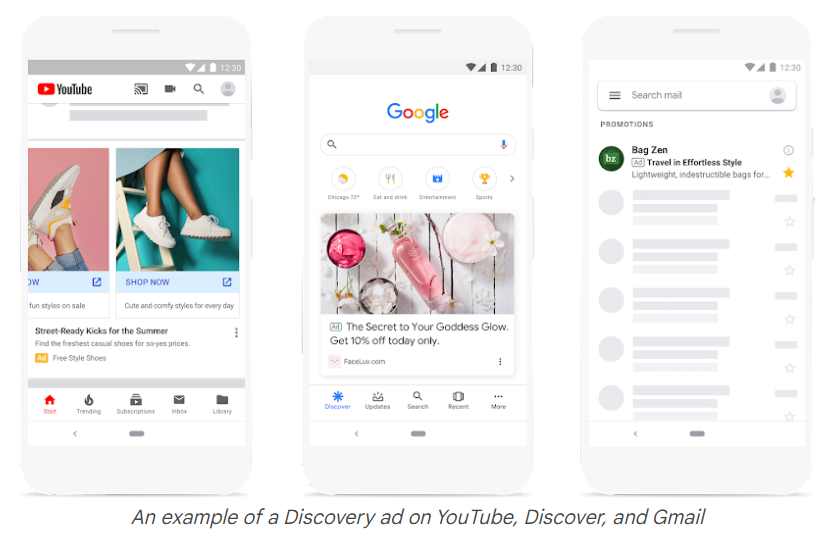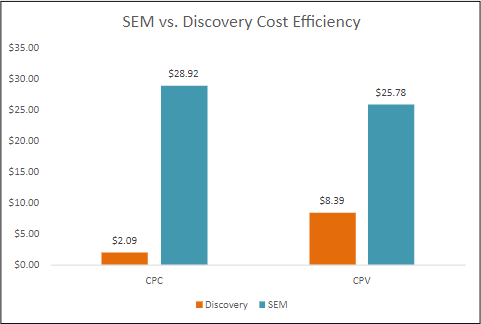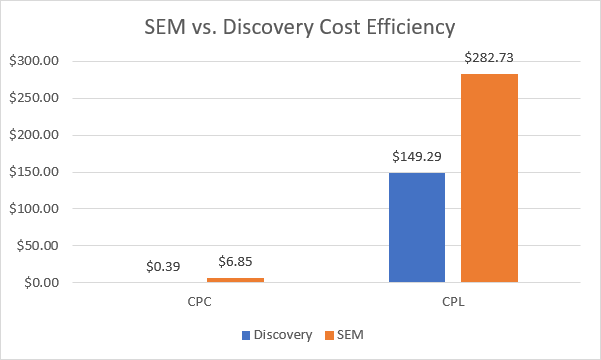B2B lead generation marketers: Have you tried Google Discovery ads yet?
According to Google, Discovery ads:
“…help you reach up to 2.9 billion people as they browse feeds on YouTube, check the Gmail Promotions and Social tabs, and scroll through Discover to catch up on their favorite topics.”
[Free Download] → B2B Lead Generation: Create Content That Converts
What Are Discovery Ads?
Unlike Search ads, Discovery ads are visual, responsive, and dynamic. Format and exact layout will depend on where the ad appears, among other factors.
Like many Google products, on initial review, Discovery ads seem to be geared toward ecommerce rather than lead generation/B2B advertisers.
All the examples in Google’s help section are shopping, or ecommerce focused.
 Screenshot from Google Ads, October 2022
Screenshot from Google Ads, October 2022As a result, B2B advertisers might be gun-shy about trying Discovery ads.
Don’t be!
We have found that Discovery ads are an efficient way to drive both awareness and leads for B2B advertisers.
How To Successfully Use Discovery Ads For Lead Generation
Discovery ads are an effective tool to use mid-funnel in the buyer journey.
The Discovery ad format falls between Google Display (upper funnel) and Search (lower funnel).
The best time to use Discovery ads for lead generation is when you’re not getting the lead volume you want from Search, possibly because you’re advertising a new product that users may not be aware of.
Discovery ads have the dual benefit of generating awareness while optimizing for conversions.
Because the ads appear beyond the search results page – in YouTube and Gmail – you’ll reach users who may be earlier in their decision journey, and help make them aware of your product.
Combine With Retargeting
As with most upper and mid-funnel tactics for lead generation, it’s important to use Discovery ads in combination with retargeting for the best results.
In fact, you can even use retargeting audiences within your Discovery campaigns. More on that in a minute.
Complement Search Campaigns
You also want to make sure you’re using Discovery in combination with Search ads.
Since Discovery ads can be targeted by keyword using a custom segment, you’ll want to be sure you’re bidding on the same keywords in your Search campaigns.
We usually use keywords from existing Search campaigns to create our Discovery custom segments.
But if you’re launching a brand new campaign, it may work the other way around; You’ll create a custom segment first and then use those keywords in a new Search campaign.
Target Competitor Keywords
Another great use of Discovery ads is to target competitor keywords.
Unlike competitor targeting in Search, which tends to be expensive due to poor quality score, competitor targeting in Discovery works more as it does in paid social.
The competitor keywords act as a signal to tell Google the type of users who would be interested in your ad.
Measuring conversions correctly is crucial to achieving successful lead generation with Discovery ads.
This is true for any Google Ads campaign, but especially so for higher-funnel ad types like Discovery.
Set Up Micro Conversions
For some B2B advertisers, true lead volume might be too low for Discovery to work efficiently.
In this case, you’ll want to set up micro conversions – non-lead actions that indicate a user is engaged and raising their hand.
Actions like viewing a video or downloading an ebook can be considered micro conversions.
Micro conversions will help drive enough signal volume to your Discovery ads campaign regarding the type of users you want to reach.
Connect Lead Sources to Google Ads
Another recommendation is to connect lead sources to Google Ads.
Usually, conversions measured in Google Ads are not qualified leads; they’re an action that indicates a lead, such as a form fill or an asset download.
These initial contacts go into a lead system, where leads are qualified and scored. These are often called “marketing qualified leads” (MQLs).
Some companies also use “sales qualified leads” (SQLs) or “advertising qualified leads” (AQLs).
Whatever you use, there is an interim step between a user successfully completing a form and becoming a lead in the CRM.
Luckily, Google Ads allows advertisers to import data on qualified leads from their CRM system. Most popular CRMs, such as Salesforce and HubSpot, are supported.
You can use your CRM data as your primary conversion if you have enough lead volume. Or you can use the data for reference just to make sure you’re actually getting qualified leads.
This is especially important if you are using lead form assets.
Often, advertisers see a high volume of poor-quality leads from lead form assets (formerly called lead extensions). Importing data from your CRM will help you see how many of these form-fills became qualified leads.
[B2B Lead Generation] Download the free ebook →
Setting Up Discovery Ads For Success
Correct campaign setup is key to successful Discovery ads campaigns.
Choose Your Targeting
Discovery ads have several different targeting options. You can target by keyword, audience, in-market, or topic targeting.
We’ve found that creating separate ad groups for each targeting option is best; that allows you to see how each option performs and optimize based on performance.
Be sure to include ad groups for relevant retargeting audiences.
If your retargeting audience is big enough, Discovery is a highly effective way to reach these users with a relevant offer that can entice them to convert.
Carefully Establish KPIs
While Discovery campaigns use the max conversions bidding strategy, you won’t want to hold them to the same key performance indicators (KPIs) as your Search campaigns.
Remember, Discovery campaigns aren’t running just in Search – they appear in YouTube search results and in Gmail.
While users in these channels may be doing some type of searching, the intent isn’t the same as it is for those searching on google.com.
You’ll find that Discovery users are further up the funnel, so your clicks per action (CPAs) will likely be higher than in Search.
Use All Available Assets For Your Ads
In addition to supplying headlines and descriptions, you’ll want to include images for your Discovery ads.
Provide all the recommended sizes/aspect ratios, as this will help ensure your ads appear in as many placements as possible.
Google suggests that advertisers use at least three headlines, descriptions, and images (in portrait, square, and landscape formats) to maximize ad delivery.
Find more Google Discovery best practices here.
A Couple Of Case Studies
We have successfully used Discovery campaigns for our B2B clients to drive leads at an efficient cost.
For one of our tech clients, we launched Discovery campaigns with the initial goal of increasing scale while maintaining efficiency.
We wanted to see how we could incorporate new campaign types into our SEM strategy and how they would fit into our existing full-funnel approach.
We launched with separate audience lists, each built into distinct ad groups. We leveraged our legacy audiences and tapped into product-based lists.
The result?
Discovery campaigns saw 690% more impressions compared to SEM campaigns. Better yet, Discovery drove 93% lower cost per click and 70% lower cost per visit.
The client was thrilled with these results and is moving forward with a large buildout of Discovery across their entire product line.
 Screenshot from author, October 2022
Screenshot from author, October 2022We saw similar performance for another client in the tech vertical. The client was already using Search, Display, and YouTube.
They had the top and bottom of the funnel covered – they just needed a mid-funnel strategy.
Enter Discovery ads.
The results for this client were nearly identical to the first example above.
Discovery ads saw significantly lower cost per click (CPCs) and lower cost per lead (CPL) than Search, with Discovery driving 60% as many leads as Search for only 32% of the cost.
 Screenshot from author, October 2022
Screenshot from author, October 2022In these two examples, Discovery ads were an efficient way to cast a wide net and reach qualified users who may not have otherwise seen our ads.
[Discover:] Expert insights & actionable tips for B2B content marketing
Caveats For Discovery Ads
As you can see, Discovery ads can be a highly effective mid-funnel tactic for driving leads. But they’re not perfect.
It’s important to understand what to watch out for when launching Discovery campaigns.
Make Sure You Have Enough Assets
This includes images and ad text.
Think of Discovery ads like paid social ads. The more ad variations you use, the easier it is to test and avoid ad fatigue.
If you only have one image and one text variation, your ads will probably not perform well. More is better.
Watch Your Impression And Click Volume
Especially if you’re using customer match audiences, you might find that volume is very low for your Discovery campaigns at first.
Remember, Discovery campaigns run on a max conversions or target CPA bid model. To drive conversions, you’ll need to drive impressions and clicks.
If that doesn’t happen soon after launch, you’ll find your volume throttled heavily as the system tries to find traffic that will convert.
Your traffic might even drop to zero.
Small customer match audiences can pose volume challenges with any campaign, but especially for Discovery, where there is no “max clicks” bidding option.
Don’t Expect Your Discovery Campaigns To Do Everything
We’ve had clients test Discovery, expecting they’ll see leads at the same cost as Search. And while I’ve shared two examples of that happening, it isn’t always the case.
We’ve tested Discovery campaigns that drove thousands of clicks but only one or two leads, with CPLs 20x that of Search.
Discovery doesn’t work for everything.
It’s also important to remember that Discovery isn’t the same as Display; CPCs will usually not be nearly as low as they are for Display.
We’ve found that Discovery CPCs are usually closer to Display than they are to Search, but they’re still about 50% higher than Display.
So if low-cost clicks are your objective, or you’re trying to build a retargeting audience, Display is a better choice than Discovery.
If you’re looking to scale your B2B lead generation efforts beyond Search, give Discovery ads a try.
They’re worth testing.
More resources:
- Google Discovery Ads Dos and Don’ts For More Successful Campaigns
- 9 Tips To Help Your B2B Google Ads Campaigns Shine
- PPC 101: A Complete Guide to Pay-Per-Click Marketing Basics
Featured Image: eamesBot/Shutterstock




